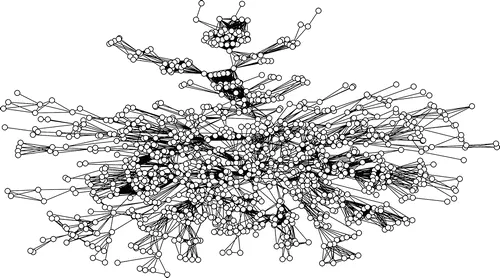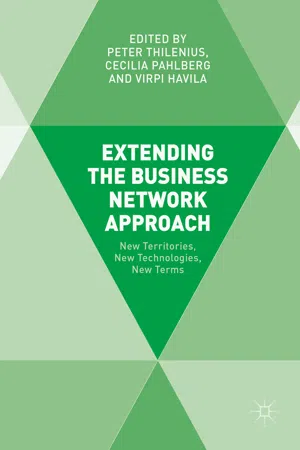Introduction
Extending the business network approach involves the researcher’s reconsideration on what assumptions should be employed when determining what is within the boundaries of the network and what is left outside. Extending also implies that something ‘new’ is presented to the business network. What is considered ‘new’ though depends on what is recognised as established within a research field. This means that ‘new’ is not necessarily novel per se, but represents a ‘new’ direction in extending the business network approach. ‘New’ in that sense is something that provokes the researcher to challenge the assumptions on boundary-setting in the business network approach, and consequently offers alternatives supported by empirical studies or conceptual reasoning. ‘New’ can involve embarking into previously unchartered territories where the business network approach allows for alternative explanations. ‘New’ can also be what the rapid technological development brings, and where the business network approach provides deeper insight into the consequences. Furthermore, ‘new’ can be altered terms for firms and markets where research following the business network approach offers complementary views on business effects.
The assumptions behind the researcher’s choice of boundary-setting within the business network thus involve more complex stances, over and above drawing geographical boundaries on a map, or setting the demarcation line between two entities. In the business network approach, boundary-setting involves deciding on a reason for the existence of networks, as well as determining what kind of relationships, and with whom, the researcher chooses to include or exclude. Furthermore, it concerns which situations the researcher deems to be appropriate venues for the business network approach and which are not. It involves what concepts the researcher decides should be part of the explanation and what are to be omitted. The assumptions on where the boundaries for the business network have been set, and reshaped during the years due to different research trends, have taken the approach in varying directions. The three directions discussed in the contributions in this volume, that is, new territories, new technologies and new terms, are chosen to represent some current trends in research following a business network approach.
The initial inspiration for the main theme of this volume, extending the business network approach, comes from the results of a study of firms’ marketing behaviour in a new situation, not encountered in prior research. In this study, the focus is on Swedish firms’ behaviour during the political crisis in Iran in the 1980s and 1990s. In the concluding discussion, regarding the theoretical implications of the study, it is noted that among the findings, one central notion is that ‘…the business network extends its boundary and includes actors from the intermediary and political systems’ (Hadjikhani 1996a: 208). The results provide evidence of the viability of adjusting the assumptions on the network boundary, that is, redefining what is included within the boundaries and thus is subject for analysis. The contributions directly related to this study (e.g., Hadjikhani 1996b, 1998; Hadjikhani and Håkansson 1996; Hadjikhani and Johanson 1996) have been characterised by Mattsson (2009: 64), in his analysis of research in Uppsala, as ‘extending the business network approach’ by incorporating the effects of politically unruly times on firms’ business relationship behaviour. This provides a good example of what extending the business network approach entails. The initial seeds planted by Hadjikhani (1996a) have over the years been cultivated, grown, and today the harvest is substantial.1 Apart from engendering and provoking additional research in a new direction, the notion of questioning and challenging the assumptions of the boundaries of the business network approach is inspiring and has proven to be fruitful. In that vein, the contributions of this volume take their departure from the received view of the business network approach and build further, thereby extending the boundaries of analysis in new directions.
The origins of the research following the business network approach have been traced back to the 1960s, and development since then has been described and analysed (cf. e.g., Engwall 1984, 1998; Thorelli 1994; Mattsson and Johanson 2006; Mattsson 2009). According to Johanson and Mattsson (2006), two books,2 both published in 1982, can be viewed as a starting-point for the business network approach. Following these inaugurating publications, many have followed, and in Chap. 2, by Lars Engwall, Cecilia Pahlberg and Olle Persson, an interesting view on the most influential contributions in terms of citation is presented. Over the years, the business network approach has developed into a set of international research streams with high vitality, covering a wide range of topics and with a rich collection of contributions all extending the business network approach.
The chapter proceeds with a section where some aspects of approaching business networks will be outlined. This is followed by a short retrospect to highlight what extending the business network further entails. The next section presents the volume’s structure, before the chapter concludes with an agenda for new research challenges calling for the further extending of the business network approach.
Approaching Business Networks
The researcher approaching business networks must, as indicated above, decide on where to set the boundaries for the network view before performing a single study. ‘Business network’ is in essence a metaphor allowing the researcher to conceptualise, analyse and understand the ramifications of firms’ business undertakings. It is the researcher’s application of this metaphor that decides what a business network becomes. Without dwelling further into the more philosophical aspects of the metaphor, it allows the researcher to develop analytical tools, which can be helpful in describing, explaining and understanding various aspects of business. The expansion of new, as well as the revision of existing, analytical tools offers further insights that extend the business network approach. However, the fact that ‘business network’ resides in a metaphor also implies that it does not exist in reality; that is, there is no actual ‘business network’ that can be studied. The business networks studied are the result of analytical efforts founded in the researcher’s choice of assumptions. To study business networks, the researcher needs to decide on these conjectures before approaching the business network to determine what it is, and what should be considered parts of it. This challenge has resulted in research which has taken different directions within the business network approach. In discussing the starting points and associated assumptions for any research following the business network approach, a representation of the metaphorical ‘business network’ can be useful. Figure
1.1 below depicts a business network illustrated as a topology of nodes connected with lines,
3 which in the business network approach is a rather commonly used figuration.
Looking at the picture of the business network from a simplistic viewpoint, the researcher who wants to approach the network is faced with two crucial concerns. The first concern is what assumptions are to be applied regarding the composition of the network; that is, what is the overall raison d’être of the business network, what does it signify and what are the accompanying implications for boundary-setting? With reference to the bu...


